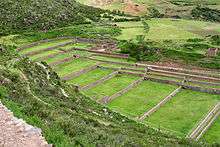Tipón
Tipón, is a sprawling early 15th-century Inca construction is situated at 3,400 meters above sea level. The complex covers 239 hectares and is located 22 kilometers southeast of Cusco near the town of Tipón.[1] It consists of wide agricultural terraces irrigated by a network of water channels fed by a natural spring. Several surrounding ruins have been excavated, and many more are visible below the soil.
 | |
| Location | Peru, Cusco Region, Quispicanchi Province, Oropesa District |
|---|---|
| Coordinates | 13°34′15″S 71°46′59″W |
| Area | 239 hectares |
Description
The Tipón complex is located near Oropesa in the Community of Choquepeda, southeast of Cusco and along the Cusco-Puno road. It contains enclosures, terraces and an intact canal. The upper complex is crossed by the Inca Trail with an irrigation canal. It was put on the List of Historic Civil Engineering Landmarks.
The site was probably used as a laboratory of agricultural products because of the various micro-climates found within the complex. Tipon is considered one of the 16 most important archaeological tours for tourists who visit the area.
Besides being an archaeological complex, the site is home to one of the largest irrigation works in the terraces, with a great distribution of outdoor water channels.
History
The true purpose of Tipón is not known. Even the original name of the Inca site is lost. The only possible written reference can be found in the Comentarios Reales de los Incas by Garcilaso de la Vega. According to de la Vega, after the Viracocha Inca usurped his father, he ordered a palace to be built for his father, Yawar Waqaq. The location of this palace is described as close to Cusco, built between the straits of Muyna and Quepicancha, near the river Tucay.[2] As Tipón is located between two mountain streams, and above the Urubamba river, some archeologists believe de la Vega was talking about Tipón.
See also
References
- "Tipon, Peru – Exploring Cusco's ancient Inca ruins". Retrieved 2016-09-14.
- de la Vega, Garcilaso, Inca (1918). "Comentarios Reales de los Incas", web version available as El Reino de los Incas del Peru, ed. by James Bardin, Professor of Romance Languages, U.VA. Allyn and Bacon.
3. Kenneth R. Wright, (2006), "Tipon: Water Engineering Masterpiece of the Inca Empire", ASCE from http://ascelibrary.org/doi/book/10.1061/9780784408513